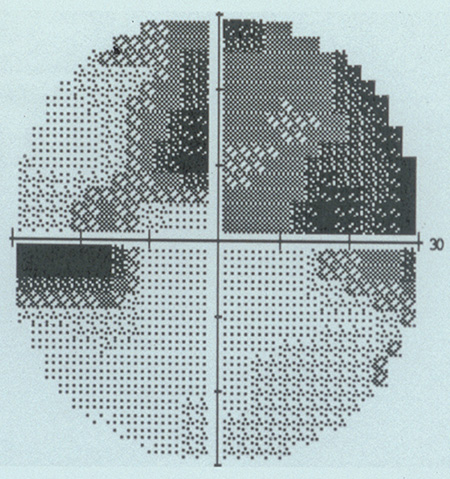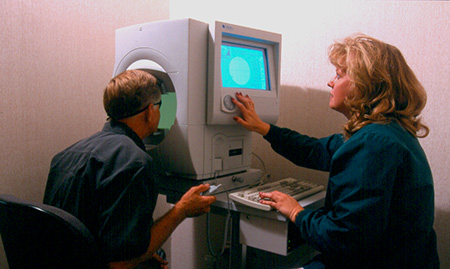Glaucoma
What is glaucoma?
Glaucoma is a disease of the optic nerve, which is the part of the eye that carries the images we see from the eye to the brain. The optic nerve is made up of many nerve fibers (like an electric cable containing numerous wires). Glaucoma damages nerve fibers, which can cause blind spots in our vision and as a result, vision loss.
There are a number of causes of glaucoma, the main being a high pressure in the eye. When the clear liquid in the eye (called the aqueous humor), cannot drain properly, pressure builds up in the eye. This can damage the optic nerve. What is a "normal" eye pressure? There is no set number: it is different for each individual. In other words, a pressure that is normal for one person's eye could be too high for someone else's eye. The challenge lies in determining the normal range for each individual.
Primary Open-angle Glaucoma
The most common form of glaucoma is primary open-angle glaucoma, where the aqueous fluid that normally circulates in the front portion of the eye is blocked from flowing back out of the eye through a tiny drainage system. This causes the pressure inside your eye to increase (intraocular pressure, or IOP), which can damage the optic nerve and lead to vision loss. Most people who develop primary open-angle glaucoma notice no symptoms until their vision is severly impaired. The loss of vision affects the side vision first, which tends not to be noticed until the patient reaches the very end stage of the disease. Once vision is lost, it cannot be recovered. The goal of treatment is to prevent further damage to the optic nerve.
Angle-closure Glaucoma
In angle-closure glaucoma, the iris (the colored part of the eye) may drop over and completely close off the drainage angle, abruptly blocking the flow of aqueous fluid and leading to increased IOP or optic nerve damage. In acute angle-closure glaucoma there is a sudden increase in IOP due to the buildup of aqueous fluid. This condition is considered an emergency because optic nerve damage and vision loss can occur within hours of the problem. Symptoms can include nausea, vomiting, seeing haloes around light, and eye pain.
Normal Tension Glaucoma
Even people with "normal" IOP can experience vision loss from glaucoma. This condition is called normal tension glaucoma. In this type of glaucoma, the optic nerve is damaged even though the IOP is considered normal. Normal tension glaucoma is not well understood, but we do know that lowering IOP has been shown to slow progression of this form of glaucoma.
Childhood glaucoma
Childhood glaucoma is rare, and starts in infancy, childhood or adolescence. Like primary open-angle glaucoma, there are few, if any, symptoms in the early stage. Blindness can result if it is left untreated. Like most types of glaucoma, this type of glaucoma may run in families.
Your eye doctor may tell you that you are at risk for glaucoma if you have one or more risk factors, including elevated eye pressure, a family history of glaucoma, a particular ethnic background, advanced age, or certain optic nerve conditions. Regular examinations are important if you are at risk for this condition. If glaucoma is suspected or diagnosed, a number of tests are performed, including measurement of corneal thickness, measurement of eye pressure, testing of peripheral vision (visual field test) and examination of optic nerves. No one test is enough to diagnose or follow glaucoma. Ongoing care is required to monitor the disease, the goal being to prevent progression.

Example of visual field loss in left eye.

Visual field testing.
